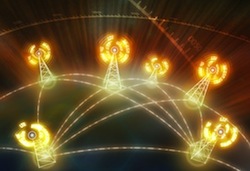The global mobile backhaul market has surpassed €6.2 billion, driven by HSPA/HSPA+ and LTE deployments, while the millimeter wave market is set to double in 2013, fuelled by LTE backhaul.
According to Infonetics’ latest report, the global macrocell mobile backhaul equipment rose seven percent between 2011 and 2012 to €6.2 billion.
“While its revenue growth rate is slowing, macrocell mobile backhaul equipment remains a huge market, with annual spending up in the €6 to €7 billion range over the next years. Just a few years ago in 2009, the market was worth under €4 billion,” said Infonetics’ Michael Howard, principal analyst for carrier networks.
“When we add to the picture small cell backhaul equipment, which we believe will total a cumulative €4 billion over five years, it becomes clear that the backhaul market is massive.”
According to Infonetics, the key drivers are HSPA/HSPA+ and LTE deployments.
Added Howard: “If you don’t have packet backhaul, there’s no way to handle HSPA and HSPA+. Ethernet and microwave backhaul spending are fuelling the whole market.”
Microwave was the largest spending segment in 2012 and continues to rise even as fibre increases. It is expected to contribute to 56 percent of mobile backhaul revenue by 2017.
As operators move gradually towards heterogeneous networks, backhaul is key for LTE and HSPA+. Despite already laying fibre, microwave vendors and operators are starting to look towards millimetre wave technology in order to backhaul hetnets.
According to Infonetics, the millimetre wave equipment market is expected to double in 2013 as major microwave vendors such as Huawei, Ericsson, Fujitsu and Aviat Networks look to launch millimeter wave products.
Millimeter waves technically encompass a great deal of spectrum from 30 to 300 Ghz, but the term is typically used to represent E-band spectrum – extremely high frequency bands from 60GHz, 71 to 76 GHz, 81 to 86 Ghz and 92 to 95 Ghz that can only be used over short distances such as a few kilometres due to high free space loss and atmospheric absorption.
Consequently, millimeter waves are ideal for small cell backhaul as the waves don’t have to travel far in a close densely-populated urban area and big blocks of the spectrum are easy to get licenses for, which means that carriers will be able to deploy large backhaul pipes that can take over 1Gbps in size.
Licensed E-band spectrum is from 70-90Ghz, while unlicensed spectrum is 60Ghz.
However Infonetics notes that at present, LTE macrocell backhaul and small cells mostly use the unlicensed 60 GHz band.
“An increasing number of mobile operators are deploying millimetre wave to augment their existing microwave macrocell backhaul deployments,” said Richard Webb, directing analyst for microwave and carrier Wi-Fi at Infonetics.
“The enhanced capacities made possible by millimeter wave are proving to be a viable solution for backhaul in metro areas where range limitations aren’t always problematic.”
Previously millimeter wave deployments were mostly for access-based applications for enterprise and fixed operator customers, but Infonetics feels that mobile backhaul has become the predominant driver of the market for the foreseeable future.
Read more: Operators to face new mobile capacity crunch by 2017 from €6.9 billion backhaul investment shortfall



